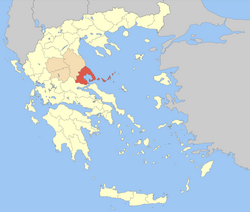Magnesia (regional unit)
|
Magnesia Περιφερειακή ενότητα Μαγνησίας |
|
|---|---|
| Regional unit | |

Municipalities of Magnesia and the Sporades
|
|
 Magnesia within Greece |
|
| Coordinates: 39°25′N 22°50′E / 39.417°N 22.833°ECoordinates: 39°25′N 22°50′E / 39.417°N 22.833°E | |
| Country | Greece |
| Region | Thessaly |
| Capital | Volos |
| Area | |
| • Total | 2,367 km2 (914 sq mi) |
| Population (2011) | |
| • Total | 190,010 |
| • Density | 80/km2 (210/sq mi) |
| Postal codes | 37x xx, 38x xx |
| Area codes | 242x0 |
| ISO 3166 code | GR-43 |
| Car plates | ΒΟ |
| Website | www |
Magnesia (Greek: Μαγνησία, Magnisía, IPA: [maɣniˈsia]), deriving from the tribe name Magnetes, is one of the regional units of Greece. It is part of the region of Thessaly. Its capital is the city of Volos. About 70% of the population of Magnesia live in the Greater Volos area, which is the second-largest city in Thessaly and the third busiest commercial port in Greece. According to the most recent census (2011), the population stands at 190,010. The regional unit hosts 2,000,000 tourists annually. Magnesia is represented in the Greek Parliament by five seats. Its main agricultural products are tomatoes, cotton, wheat, olives, olive oil and dried nuts, especially almonds and pistachios.
A prominent geographic feature of Magnesia is the Pagasetic Gulf, a bay of the Aegean Sea. The Pelion mountain range closes off the Gulf on the east and south side, leaving only a narrow channel near Trikeri. The highest peak of the wooded Pelion is Pourianos Stavros or Xeforti, (altitude 1,624 metres or 5,328 feet). On the south edge of Magnesia peninsula Tisaio mountain is found.
Mt. Maurovouni (1,054 metres or 3,458 feet) is the northeasternmost mountain of the regional unit and extends to the neighboring regional unit of Larissa. The southwest border of Magnesia is formed by the Othrys, with its highest peak Gerakovouni (1,726 metres or 5,663 feet). The interior of Magnesia has two plains. The plains southwest of the Pagasetic Gulf arecalled Almyros plains, while the plains northwest of the Gulf are called the Volos-Velestino plain. The hydrological network of Magnesia is not particularly rich and is characterized by the absence of big rivers. The waters coming from Pelion shape the rivers Anavros, Platanorema, and Xirias.
...
Wikipedia
